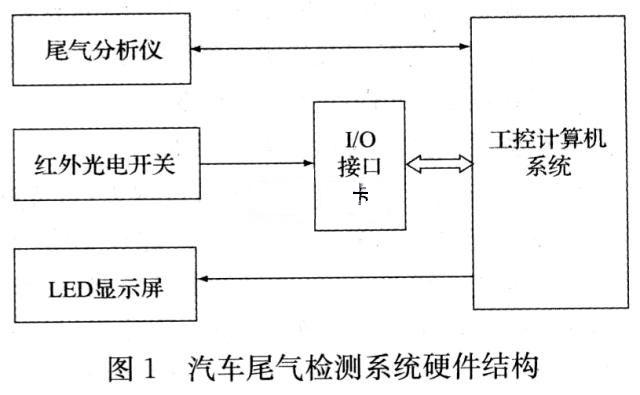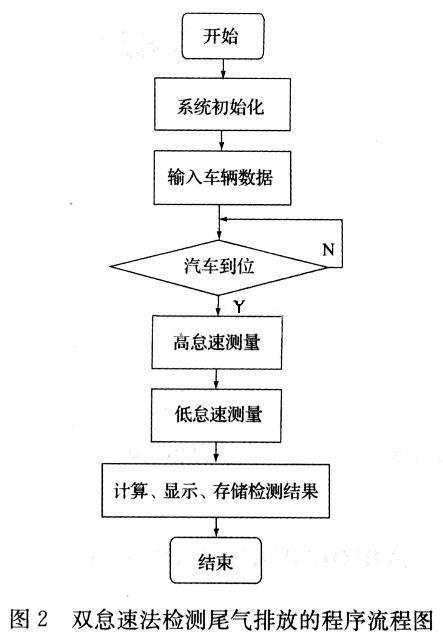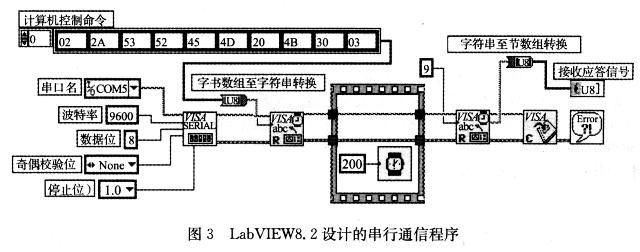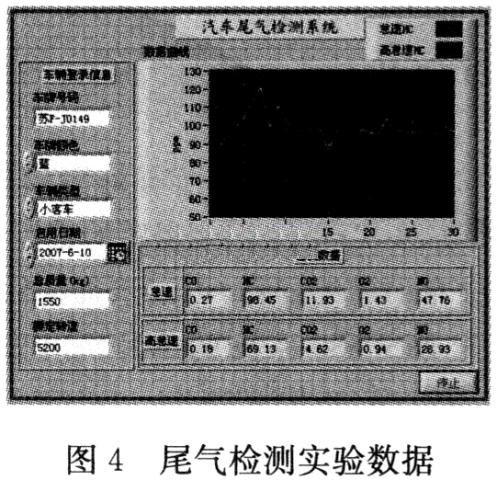Automobile exhaust gas detection system based on virtual instrument technology
Abstract: In order to monitor and prevent environmental pollution caused by automobile exhaust emissions, this paper introduces an automobile exhaust detection system based on virtual instrument technology. First, the composition and working principle of the detection system are introduced, and a method for designing an automobile exhaust detection system is proposed, using the graphical programming language LabVIEW8.2 launched by the American NI company as the development environment and the VS5067-5 produced by the German Siemens company as the exhaust analyzer. In particular, the LabVIEW8.2 implementation of the industrial control computer and the VS5067-5 serial communication program is introduced in detail. The actual test results show that the method is convenient and practical, and has the value of promotion and application.
0 Introduction
In recent years, with the rapid development of my country's social economy and the continuous improvement of people's living standards, the number of cars has increased significantly. While cars bring convenience to people's daily lives, they also bring serious environmental problems. Harmful gases such as CO and HC compounds in automobile exhaust have become the main source of air pollution. Therefore, monitoring and preventing automobile exhaust pollution is an important task in controlling environmental pollution.
To control the exhaust pollution of motor vehicles, the first thing is to do a good job of detection. In my country, since 1999, a series of corresponding laws and regulations have been formulated to strictly control the emission of automobile exhaust. In 2005, the new national standard GB 18285-2005 "Limits and measurement methods for exhaust pollutants from spark-ignition engines" was promulgated. In addition to the requirements for the measurement method of exhaust pollutants of automobiles under idle and high idle conditions, the standard also clearly stipulates the emission limits of exhaust pollutants for each type of automobile.
The main detection parameters of automobile exhaust pollutants are: CO (carbon monoxide), HC (hydrocarbons), CO2 (carbon dioxide), O2 (oxygen), NO (nitrogen monoxide), etc.
1 Composition of the detection system
The hardware structure of the automobile exhaust detection system based on virtual instrument technology is shown in Figure 1.

The detection system is mainly composed of exhaust gas analyzer, I/O interface card, infrared photoelectric switch, LED display screen and industrial control computer. The exhaust gas analyzer uses VS5067-5 automobile exhaust gas analyzer of Siemens of Germany. The core component of the instrument is infrared optical
The I/O interface card expanded on the industrial computer is mainly used to receive the on/off status of the infrared photoelectric switch to determine whether the inspected vehicle is in place. The infrared photoelectric switch uses the Omron E3JK-5M model, and its infrared beam distance is 5m. The infrared transmitting photoelectric tube and the infrared receiving photoelectric tube are installed on both sides of the vehicle inspection line. When the infrared transmitting tube is not blocked, the receiving photoelectric tube is in a normally closed state. When the inspected vehicle drives to the inspection station and blocks the infrared transmitting photoelectric tube, the receiving photoelectric tube is in an open state. The open and closed states of the receiving photoelectric tube indicate whether the vehicle is in place.
The LED display screen is used to display the test process information and test results. The driver and exhaust emission inspector can perform corresponding operations under the guidance of the information displayed on the LED display screen.
The working process of the exhaust gas detection system is as follows: when the vehicle logs in for online detection, the industrial control computer sends a vehicle entry message to prompt the vehicle to enter the detection station. When the industrial control computer detects that the receiving photoelectric tube is in the off state, it means that the vehicle is in place and the exhaust gas detection can begin. The detection procedure will be carried out according to the measurement method specified in the national standard GB18285-2005. During the detection process, the exhaust emission inspector inserts the sampling probe into the exhaust pipe of the vehicle to be inspected according to the instructions on the LED display screen, and connects the speed measuring clamp to the relevant parts of the engine as required; the exhaust gas analyzer receives the command of the industrial control computer from the serial port to collect exhaust pollutants; the driver manipulates the car to enter the rated speed, high idle speed, idle speed and other states according to the instructions on the LED display screen, and cooperates with the exhaust gas analyzer to complete the exhaust emission measurement according to the detection procedure.
2. Detection software design
Software is the key to virtual instruments. When designing a virtual instrument system, after the hardware platform is determined, different functions can be realized by designing different software modules. The application software of the automobile exhaust detection system is developed using NI's graphical programming language LabVIEW8.2 and is modularly designed. The program flow chart for detecting exhaust emissions using the dual idle method is shown in Figure 2.
The execution process of the dual idle exhaust gas detection program is as follows: first, input the basic information of the vehicle to be inspected on the main program interface, then prompt the vehicle to enter the inspection station through the LED display screen, and judge the vehicle's arrival by reading the state of the infrared receiving photoelectric tube. If the vehicle is in place, the exhaust emission test is carried out according to the dual idle measurement method specified in the national standard, and the test data is input through the serial port. Finally, the data is calculated, and the test results are displayed and stored. For intuitiveness, the collected raw data can be output in the form of a curve chart.

In the design of the detection program, since the industrial computer and the exhaust gas analyzer transmit measurement commands and measurement data through the serial port, the serial communication program is one of the most critical modules in the detection software. In LabVIEW8.2, the VISA module can be used to write the serial communication program, which can get rid of the cumbersome low-level commands and easily realize the communication between the industrial computer and the instrument.
The communication parameters of VS5067-5 automobile exhaust analyzer are: 9600 baud rate, 8 data bits, no parity check, 1 stop bit, and the communication commands include: computer control, CAL, measurement, read data, end measurement, manual operation, etc. The command format is a multi-byte ASCII code. For example, the "computer control" command is: 02H, *, S, R, E, M, 20H, K, O, 03H, that is, 10 bytes of ASCII code. Similarly, the instrument's response signal is also a multi-byte ASCII code. For example, the response signal corresponding to the "computer control" command is a 9-byte ASCII code, namely: 02H, *, S, R, E, M, 20H, 0, 03H. In other words, the serial data between the industrial control computer and the exhaust gas analyzer are all multi-byte ASCII code information. Since it is more convenient to express ASCII code in hexadecimal in program development, there is a problem of data type conversion in serial transmission and reception of data. In LabVIEW8.2, the conversion between ASCII code and hexadecimal data can be easily realized by using the two functions of "byte array to string conversion" and "string to byte array conversion". Taking sending the "computer control" command as an example, the serial communication program designed by LabVIEW8.2 is shown in Figure 3.
The writing process of the serial communication program is as follows:
1) Serial port initialization
According to the communication protocol of VS5067-5 automobile exhaust analyzer, use the "VISA Configure Serial Port" function in the [Data Communication] → [Protocol] → [Serial Port] sub-selection panel of LabVIEW8.2 function selection panel to initialize the serial port to a baud rate of 9600bps, 8 data bits, 1 stop bit, no parity bit, and select the COM1 port of the industrial control computer.
2) Send measurement command
When the industrial computer wants to send a measurement command to the exhaust gas analyzer, it can use the "VISA write" function to send it. Since the exhaust gas analyzer's command is in multi-byte ASCII format, it is necessary to group the command into an array, and then use the "byte array to string conversion" function to convert the array into a string for sending. Figure 3 shows the sending of the "computer control" command. The hexadecimal representation of the "computer control" command is: 02H, 2AH, 53H, 52H, 45H, 4DH, 20H, 4BH, 30H, 03H.

3) Receive response signal
When the exhaust gas analyzer receives the command from the industrial computer, it will return a response signal accordingly. In program design, the "VISA read" function can be used to receive the instrument's response signal, and then the "string to byte array conversion" function can be used to convert the received ASCII data into hexadecimal data. For example, when the instrument receives the "computer control" command, the returned response signal is expressed in hexadecimal as: 02H, 2AH, 53H, 52H, 45H, 4DH, 20H, 30H, 03H. If the industrial computer sends a "read data" command to the instrument, the response signal returned by the instrument will include HC, CO, CO2, O2, NO, as well as speed, oil temperature, λ (excess air coefficient) and other detection data.
4) Close the serial port
When the industrial computer wants to stop exhaust gas detection, the "VISA Close" function can be used to close the serial port and release the resources occupied by LabVIEW.
3 Experimental Results
We conducted multiple car exhaust detection experiments on the car exhaust detection system developed based on LabVIEW8.2. During the experiment, different car types were selected and a large amount of experimental data was obtained. Figure 4 shows the measurement results of a small passenger car. The figure shows the original data curves of idle and high idle HC. You can also choose to display the data curves of CO or other parameters.

4 Conclusion
This system uses LabVIEW8.2 as the development platform, and can conveniently detect the concentration of automobile exhaust pollutants such as HC, CO, CO2, O2, and NO. The experimental results show that the system has high stability and measurement accuracy. In addition, by configuring a network card on an industrial computer, the network detection of automobile exhaust can be realized, so that the automobile exhaust detection system can be easily applied to new car research and development experiments, new car factory inspections, and the comprehensive performance test line of automobiles for regular inspections of vehicles on the road by traffic management departments. The application prospects are very broad.
Previous article:The process principle of laser plastic welding
Next article:Discussion on the relationship between voltage power factor and rural power grid loss reduction
- High signal-to-noise ratio MEMS microphone drives artificial intelligence interaction
- Advantages of using a differential-to-single-ended RF amplifier in a transmit signal chain design
- ON Semiconductor CEO Appears at Munich Electronica Show and Launches Treo Platform
- ON Semiconductor Launches Industry-Leading Analog and Mixed-Signal Platform
- Analog Devices ADAQ7767-1 μModule DAQ Solution for Rapid Development of Precision Data Acquisition Systems Now Available at Mouser
- Domestic high-precision, high-speed ADC chips are on the rise
- Microcontrollers that combine Hi-Fi, intelligence and USB multi-channel features – ushering in a new era of digital audio
- Using capacitive PGA, Naxin Micro launches high-precision multi-channel 24/16-bit Δ-Σ ADC
- Fully Differential Amplifier Provides High Voltage, Low Noise Signals for Precision Data Acquisition Signal Chain
- Innolux's intelligent steer-by-wire solution makes cars smarter and safer
- 8051 MCU - Parity Check
- How to efficiently balance the sensitivity of tactile sensing interfaces
- What should I do if the servo motor shakes? What causes the servo motor to shake quickly?
- 【Brushless Motor】Analysis of three-phase BLDC motor and sharing of two popular development boards
- Midea Industrial Technology's subsidiaries Clou Electronics and Hekang New Energy jointly appeared at the Munich Battery Energy Storage Exhibition and Solar Energy Exhibition
- Guoxin Sichen | Application of ferroelectric memory PB85RS2MC in power battery management, with a capacity of 2M
- Analysis of common faults of frequency converter
- In a head-on competition with Qualcomm, what kind of cockpit products has Intel come up with?
- Dalian Rongke's all-vanadium liquid flow battery energy storage equipment industrialization project has entered the sprint stage before production
- Allegro MicroSystems Introduces Advanced Magnetic and Inductive Position Sensing Solutions at Electronica 2024
- Car key in the left hand, liveness detection radar in the right hand, UWB is imperative for cars!
- After a decade of rapid development, domestic CIS has entered the market
- Aegis Dagger Battery + Thor EM-i Super Hybrid, Geely New Energy has thrown out two "king bombs"
- A brief discussion on functional safety - fault, error, and failure
- In the smart car 2.0 cycle, these core industry chains are facing major opportunities!
- Rambus Launches Industry's First HBM 4 Controller IP: What Are the Technical Details Behind It?
- The United States and Japan are developing new batteries. CATL faces challenges? How should China's new energy battery industry respond?
- Murata launches high-precision 6-axis inertial sensor for automobiles
- Ford patents pre-charge alarm to help save costs and respond to emergencies
- EEWORLD University Hall----Live Replay: MPS Inductor Solutions Help Better Switching Power Supply Design
- High-precision humidity and temperature sensor
- 【NUCLEO-L552ZE Review】+ Planning & Preparation
- After cc2530 successfully creates a network, p1_0 immediately becomes low level
- RF and Microwave Passive Component Design Considerations and Limitations
- Let's see! Detailed explanation of the components of a switching power supply
- SCI Interface and Hardware Implementation of TMS320C6711D
- Non-magnetic AC/DC Power Supplies
- S5PV210 Timer
- Tax control machine industry: a promising industry worth paying attention to, with different future prospects for related listed companies

 Design of Data Acquisition System Based on PC/104
Design of Data Acquisition System Based on PC/104 LabVIEW (Laboratory Virtual instrument Engineering) is a graphical programming language
LabVIEW (Laboratory Virtual instrument Engineering) is a graphical programming language











 京公网安备 11010802033920号
京公网安备 11010802033920号